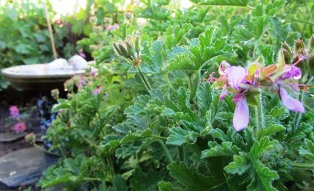Backyard Fruit Compote
Who feels like eating when the shorts and sandals weather has turned hot enough to warrant wearing bikini bottoms and thin cotton T-shirt for doing your household chores? Bring on the cool summer salads.
When the temperatures hit 105 on the farmette yesterday, we opted for a simple supper of cold chicken, orzo with Italian vinegar and oil dressing, and cold potato salad.
With nectarines and peaches ripening now on our trees, blueberries finally sweet enough to eat, and strawberries available at our local farmers’ market, what could be better for a dessert on a hot summer’s evening than a fruit compote.
Recipe for Backyard Fruit Compote
Gather the fruit, including nectarines, peaches, plums, strawberries, blueberries, kiwi, and melon.
Wash, and slice the nectarines, peaches, plums, and strawberries.
If including melon in the compote, scoop the melon into ball shapes using a melon baller or cut pieces of melon into cubes.
Peel and slice the kiwi.
Toss all into a bowl, adding the blueberries.
Sprinkle lightly with a scented sugar, or a super fine sugar, or honey.
Or, make a dressing: mix together 1/4 cup of lime juice, 1/4 cup of honey, 1 teaspoon of orange zest, 1 teaspoon of lime zest, and 1/2 teaspoon finely grated ginger. Pour over the fruit. Chill for about 1 hour and add springs of mint before serving.
Scented Geranium Leaves for the Garden and the Kitchen
Like the British monarch Queen Victoria, I am a lover of Pelargoniums, popularly called scented geraniums. Tucked in between a hedge of French perfume lavender, hydrangeas, and purple bearded iris in my garden is a rose-scented geranium with tiny pink flowers. I started it from a slip off my Lebanese-American neighbor’s plant and now it’s as large as a wine barrel. The varieties I grow aren’t just relegated to my garden; I have some in pots, within easy reach for culinary purposes.
My favorite, however, is the rose geranium. If I happen to brush against the leaves, the plant releases a heady perfume that scents the whole area like an old rose garden. Scented geraniums are actually unrelated to the true geranium of woodland habitat. The scented geraniums are of the genus Pelargonium, beloved of the Victorians, their monarch, my grandmother, and gardeners like me.
Indigenous to South Africa, the scented-leaf geraniums are half-hardy perennials in many parts of the United States. Once so popular there were 250 varieties or more, the plant fell out of favor after the Great War. Today’s gardener will find scents such as apple, apricot, chocolate, cinnamon, coconut, ginger, lemon, lime, mint, nutmeg, orange, pepper, pineapple, rose and strawberry, to name a few.
The leaves run the gamut of shapes, from deeply cut angles to round shapes that appear crinkled. Some leaves are smooth while others are leathery or velvety. The colors range from intense shades of green and yellowish-green to a reddish-purple hue. The lemon-scented Pelargonium crispum has small, green, crinkled leaves, for example, but the Pelargonium tomentosum features large and velvety leaves of a green-gray hue and yield a peppermint scent.
They need sun and a well-drained, slightly acidic soil. To propagate, take cuttings before the plant flowers. Keep the cuttings in water until roots form or put them in a planting mixture and keep moist until new leaves spr0ut.
Easy to grow, delightfully scented, with pretty little leaves and flowers, scented geraniums were beloved by our grandmothers and theirs before them. In any garden, they lend a generous helping of old-fashion charm. Plus, many of them can be used in homemade soaps and cosmetics. Cooks like them for their culinary uses as a scent source for sugars, or for tea, or as garnishes for cakes and salads and fruit dishes.
The process of making a scented sugar for tea or icing is quite simple. You’ll need a cup of sugar and a cup of leaves from a scented geranium. Try rose, lemon, or mint.
1. Gather a cupful of leaves
2. Thoroughly wash and dry the leaves.
3. Using one cup of sugar, alternate layers of 1 inch of sugar and a layer of leaves (some chefs say to slightly bruise to release more flavor).
4. Tightly screw the lid onto the jar.
5. Store in a warm place for 2 to 4 weeks
6. Remove the leaves (try sifting the sugar in a bowl to get all the leaves out)
7. Re-jar the scented sugar and use as needed.
 Facebook
Facebook Goodreads
Goodreads LinkedIn
LinkedIn Meera Lester
Meera Lester Twitter
Twitter







